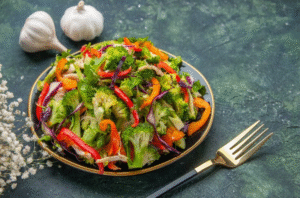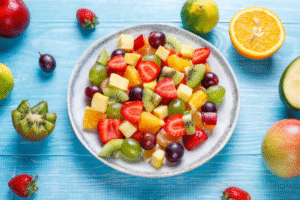Fruit salad is a fun and healthy dish that you can enjoy as a snack, a side dish, or even a light meal. But did you know that some fruit salads can have a lot of calories? In this article, we’ll explain how to make a fruit salad that is both low in calories and packed with nutrients. Whether you’re making it for yourself or serving it to family and friends, you’ll be able to enjoy a tasty and healthy treat!
What Goes into the Calories of a Fruit Salad?
When you make a fruit salad, most of the calories come from the fruits themselves. Some fruits have more calories than others, so it’s important to pick a good mix if you’re trying to keep it light.
How Fruit Salad Gets Its Calories
Fruits are all natural and good for you, but different fruits have different amounts of calories. For example, bananas and grapes are higher in calories than watermelon or strawberries. If you add too many calorie-heavy fruits, your salad can become high in calories. So, it’s important to pick a mix that balances both low-calorie and slightly higher-calorie fruits.
The Portion Size Matters
How much fruit salad you eat is also important. A small bowl of fruit salad may only have 100-150 calories, but if you eat a big bowl, you could end up with 200-250 calories or more. Keeping an eye on the size of your serving helps control how many calories you’re eating.
What Else You Add Matters
Sometimes people add things like syrup, whipped cream, or sugary dressings to their fruit salad. While these can make the salad taste sweeter, they also add extra calories. To keep your fruit salad light, it’s best to use fresh fruit without adding too much extra stuff.
Popular Fruits in Fruit Salad and Their Calories
The fruits you put in your salad will decide how many calories it has. Here’s a look at some common fruits and how many calories they contain:
Apples
- Calories per 100g: 52
- Calories per medium apple (about 150g): 78
Apples are a great choice for fruit salads because they’re low in calories and high in fiber.
Bananas
- Calories per 100g: 89
- Calories per medium banana (about 118g): 105
Bananas are higher in calories than apples and other fruits, so be careful not to use too many if you’re watching your calorie intake.
Berries (Strawberries, Blueberries, Blackberries)
- Calories per 100g (strawberries): 32
- Calories per 100g (blueberries): 57
- Calories per 100g (blackberries): 43
Berries are low in calories and full of vitamins. They’re perfect for a healthy fruit salad!
Oranges
- Calories per 100g: 47
- Calories per medium orange (about 130g): 61
Oranges are also low in calories and a great source of vitamin C, making them a sweet and healthy choice for your salad.
Melons (Watermelon, Cantaloupe)
- Calories per 100g (watermelon): 30
- Calories per 100g (cantaloupe): 34
Watermelon and cantaloupe are both low in calories and very hydrating, which makes them a refreshing addition to any fruit salad.
Fruit Calorie Comparison Table
| Fruit | Calories per 100g | Calories per Medium Serving |
| Apples | 52 | 78 |
| Bananas | 89 | 105 |
| Strawberries | 32 | 25 (for 1/2 cup) |
| Oranges | 47 | 61 |
| Watermelon | 30 | 45 (for 1 cup) |
How to Build a Low-Calorie Fruit Salad
If you want to make a fruit salad that’s light on calories but still delicious, here are a few tips.
Choose Low-Calorie Fruits
Pick fruits that are naturally low in calories, like strawberries, watermelon, and citrus fruits (like oranges). These fruits will keep your salad light and refreshing.
Add Fiber-Rich Fruits
Fiber helps keep you full for longer and is good for digestion. Fruits like apples, pears, and berries are high in fiber, so they’re great for making a healthy salad.
Keep Portion Sizes in Check
Even healthy fruits can add up in calories if you eat too much. Make sure to keep your portions small, so you don’t end up eating too many calories.
Skip Sugary Add-ins
Avoid adding sugar, syrup, or whipped cream to your fruit salad. Instead, use the natural sweetness of the fruit to flavor your salad. If you want a little extra sweetness, try adding a drizzle of honey or a sprinkle of cinnamon.
Why Eating Fruit Salad is Good for You
Fruit salad is a great way to get lots of vitamins, minerals, and fiber into your diet. Here are some of the benefits of eating fruit salad:
Full of Important Nutrients
Fruit salad is full of vitamins like vitamin C, vitamin A, and folate. These nutrients are important for your health, helping your body stay strong and healthy.
High in Fiber
Fruits like apples, pears, and berries have a lot of fiber, which helps with digestion and keeps you full longer.
Keeps You Hydrated
Fruits like watermelon and oranges have a lot of water in them, so eating fruit salad is a great way to stay hydrated. This is especially helpful in hot weather.
Good for Weight Management
Fruit salads are low in calories but high in fiber, making them a great snack if you’re trying to manage your weight. They’re filling, so you won’t feel hungry soon after eating them.
Smart Add-Ins for Your Fruit Salad
Want to make your fruit salad even better? Try adding these ingredients that are healthy and won’t add too many calories:
Greek Yogurt
Greek yogurt is creamy and full of protein, making it a good choice for adding to your fruit salad. Stick with plain, non-fat yogurt to keep it light.
Nuts and Seeds
Adding a few nuts or seeds to your fruit salad gives it a nice crunch. Just be careful not to add too many, since they can be high in calories. A small sprinkle of almonds, chia seeds, or sunflower seeds is enough to give your salad a little extra texture.
Fresh Herbs
Fresh herbs like mint, basil, or cilantro can give your fruit salad a fresh and exciting flavor. They’re low in calories and add a nice twist to your salad.
Spices
Spices like cinnamon, ginger, or nutmeg can make your fruit salad taste even better. They’re great for adding extra flavor without adding any extra calories.
Fruit Salad Dressings: Healthy Alternatives
If you like dressing on your fruit salad, it’s better to make your own instead of using store-bought ones that can be high in sugar. Here are a few ideas:
Simple Lemon or Lime Dressing
Lemon or lime juice adds a tangy flavor to your fruit salad without adding any extra calories. You can also mix in a little honey for natural sweetness.
Yogurt-Based Dressing
Greek yogurt can be used to make a creamy dressing for your fruit salad. Combine it with a little honey, vanilla extract, and lemon juice to make a light and delicious dressing.
Mistakes to Avoid When Making a Fruit Salad
To make sure your fruit salad is as healthy as possible, here are some common mistakes to avoid:
Overloading on High-Calorie Fruits
Some fruits, like bananas and grapes, are higher in calories than others. While they’re healthy, it’s a good idea to use them in moderation to keep the calorie count low.
Using Too Much Dressing
Dressings can add extra sugar and calories to your fruit salad. Be careful not to pour too much dressing on your salad. Instead, use a light hand and only add a little.
Using Too Much Sugar
Fruit is naturally sweet, so you don’t need to add extra sugar to your fruit salad. If you feel like it needs a little extra sweetness, try using honey or a sprinkle of cinnamon.
Conclusion: Make Your Fruit Salad Light and Nutritious
Fruit salad is a great way to enjoy a healthy and tasty treat. By choosing the right mix of fruits, keeping your portion sizes in check, and avoiding sugary add-ins, you can make a fruit salad that is both low in calories and full of nutrients. Whether you’re making it for yourself or sharing it with others, fruit salad is a simple and delicious way to eat healthy!






